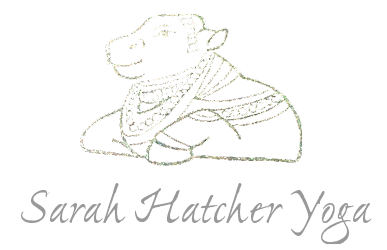Yoga Sutras for Everyone
I find that when I clean my bathroom on Thursdays, I turn into a fembot. Ok, so I am exaggerating, but my mind wanders just to one place, that of resentment and anger. Thanks to the tools I have learned from ashtanga yoga, I have been able to curtail these thoughts of destruction and ire and channel them towards enlightenment. My sweet trick, you may ask?
The Yoga Sutras of Patanjali. Yep, I listen and chant the YS of Patanjali while I clean, while I cook, while I do wee chores around my home so that I am in a state of meditation and concentration. A few hours go by and I am surprised how shiny my bathroom looks and amazed that I didn't turn into a demon.
Adding spiritual study to your yoga practice - Svadyaya - is a key component - in fact it is the backbone that supports niyama - the second limb of ashtanga yoga. Having svadyaya in your practice arsenal will allow you to access a greater part of yourself that may be hidden or covered up.
One translation of svadyaya means studying sacred texts. Which sacred texts should you be reading as a keen yogi? Two for sure: the Bhadgavad Gita and the Yoga Sutras of Patanjali. They specifically bring our lessons from practice and show us how to bring them into our day. This is especially important when we are having an adult meltdown.
One great way to begin studying the yoga sutras is to find a teacher who you like. Do some research online and search for an online teacher. I recommend learning from the Mohan family and with Nitya Mohan at the Yoga Sutras Online website. This gives you the opportunity to listen to detailed philosophical insight on the Yoga Sutras of Patanjali and learn how to properly chant the sutras.
I recommend just like an asana practice, only chanting as far as you can remember. So when you begin, you don't learn the first twenty. You learn the first two. You get those two down to memory, then you add one more. Just like an asana practice, you don't go do the entire primary and see how it goes. You learn it one asana at a time so that you fully learn the postures before adding another one on.
Another way to study the sutras is to get a practical book that you like. Edwin Bryan't book, "The Yoga Sutras of Patanjali' is as in-depth of a book as you can get and for the beginning student, it may be a bit much. Mind you it is perfect if you are a seasoned YS buff, because it goes into great detail of commentary from Vyasa, the wise-expert on the Yoga Sutras. Dive into this book with a bit of courage as it will give you many perspectives on the sutras.
A practical and all levels book which is great for beginning as well as intermediate students is B.K.S. Iyengar's book, "Light on the Yoga Sutras of Patanjal". This book is a gem; it is filled with easy-to-read descriptions of the sutras, but unlike Bryan't book, does not have much commentary from Vyasa. What Iyengar's book will offer you is a simple outline of the sutras and a roadmap of them too - you can trace how and which sutras relate to each other. And this is always good if you are trying to bring the wisdom of the sutras into your daily practice.
Here are two videos of me chanting Book 1 and Book 2 of the sutras. It took me a few years to memorize these two chapters. So remember, take your time and read, study and repeat. And notice, I am a novice, still just learning!
In the second book, you'll see I have made a mistake - and I repeat the sutra I fumbled at the end. Can you hear which one is a miss? This sutra is a landmark sutra of Book 2 and this is why I must get it right.
I always thank Timbo, my sweet husband for introducing me to sincere sutra chanting; now, it is just as important as the asana practice.
May your chanting be filled with Joy!
The Yoga Sutras of Patanjali. Yep, I listen and chant the YS of Patanjali while I clean, while I cook, while I do wee chores around my home so that I am in a state of meditation and concentration. A few hours go by and I am surprised how shiny my bathroom looks and amazed that I didn't turn into a demon.
Adding spiritual study to your yoga practice - Svadyaya - is a key component - in fact it is the backbone that supports niyama - the second limb of ashtanga yoga. Having svadyaya in your practice arsenal will allow you to access a greater part of yourself that may be hidden or covered up.
One translation of svadyaya means studying sacred texts. Which sacred texts should you be reading as a keen yogi? Two for sure: the Bhadgavad Gita and the Yoga Sutras of Patanjali. They specifically bring our lessons from practice and show us how to bring them into our day. This is especially important when we are having an adult meltdown.
One great way to begin studying the yoga sutras is to find a teacher who you like. Do some research online and search for an online teacher. I recommend learning from the Mohan family and with Nitya Mohan at the Yoga Sutras Online website. This gives you the opportunity to listen to detailed philosophical insight on the Yoga Sutras of Patanjali and learn how to properly chant the sutras.
I recommend just like an asana practice, only chanting as far as you can remember. So when you begin, you don't learn the first twenty. You learn the first two. You get those two down to memory, then you add one more. Just like an asana practice, you don't go do the entire primary and see how it goes. You learn it one asana at a time so that you fully learn the postures before adding another one on.
Another way to study the sutras is to get a practical book that you like. Edwin Bryan't book, "The Yoga Sutras of Patanjali' is as in-depth of a book as you can get and for the beginning student, it may be a bit much. Mind you it is perfect if you are a seasoned YS buff, because it goes into great detail of commentary from Vyasa, the wise-expert on the Yoga Sutras. Dive into this book with a bit of courage as it will give you many perspectives on the sutras.
A practical and all levels book which is great for beginning as well as intermediate students is B.K.S. Iyengar's book, "Light on the Yoga Sutras of Patanjal". This book is a gem; it is filled with easy-to-read descriptions of the sutras, but unlike Bryan't book, does not have much commentary from Vyasa. What Iyengar's book will offer you is a simple outline of the sutras and a roadmap of them too - you can trace how and which sutras relate to each other. And this is always good if you are trying to bring the wisdom of the sutras into your daily practice.
Here are two videos of me chanting Book 1 and Book 2 of the sutras. It took me a few years to memorize these two chapters. So remember, take your time and read, study and repeat. And notice, I am a novice, still just learning!
In the second book, you'll see I have made a mistake - and I repeat the sutra I fumbled at the end. Can you hear which one is a miss? This sutra is a landmark sutra of Book 2 and this is why I must get it right.
I always thank Timbo, my sweet husband for introducing me to sincere sutra chanting; now, it is just as important as the asana practice.
May your chanting be filled with Joy!
Book 1 Samadhi Pada
Book 2 Sadhana Pada

